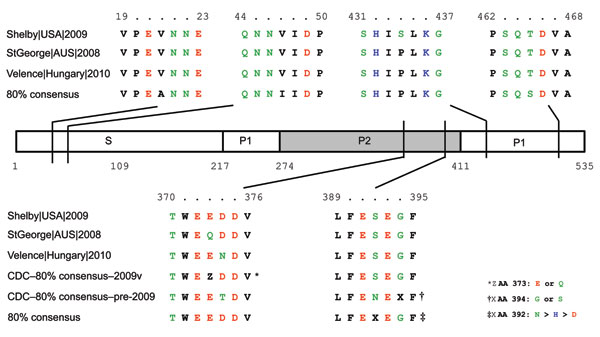Volume 17, Number 8—August 2011
Dispatch
Novel GII.12 Norovirus Strain, United States, 2009–2010
Figure 2

Figure 2. GII.12 norovirus viral protein (VP) 1 cartoon depicting amino acid similarities and locations between 2009–10 GII.12 strains and pre-2009 GII.12 strains. The S, P1, and P2 domains of VP1 are labeled accordingly. The VP1 amino acid numbering is based on the GII.12 prototype strain Wortley (GenBank accession no. AJ277618). Amino acid types are indicated by colors: green, polar; blue, basic; red, acidic; and black, hydrophobic. The 80% consensus sequence is based on a VP1 consensus sequence from the following GII.12 strains: GenBank accession nos. EU921353, AF427119, AJ277618, EF547403, AB044366, AB032758, AF414420, AB045603, AB067536, AB039775, and AF397905. Three recombinant 2009–2010 GII.12 strains—StGeorge (accession no. GQ845370), Velence (accession no. HQ115742), and Shelby (accession no. HQ688986)—were not included. The Centers for Disease Control and Prevention (CDC)–80% consensus–2009v and CDC–80% consensus–pre-2009 sequences are based on an 80% consensus P2 sequence from samples received from 2009–2010 (2009v) or from sample before 2009 (pre-2009), respectively.